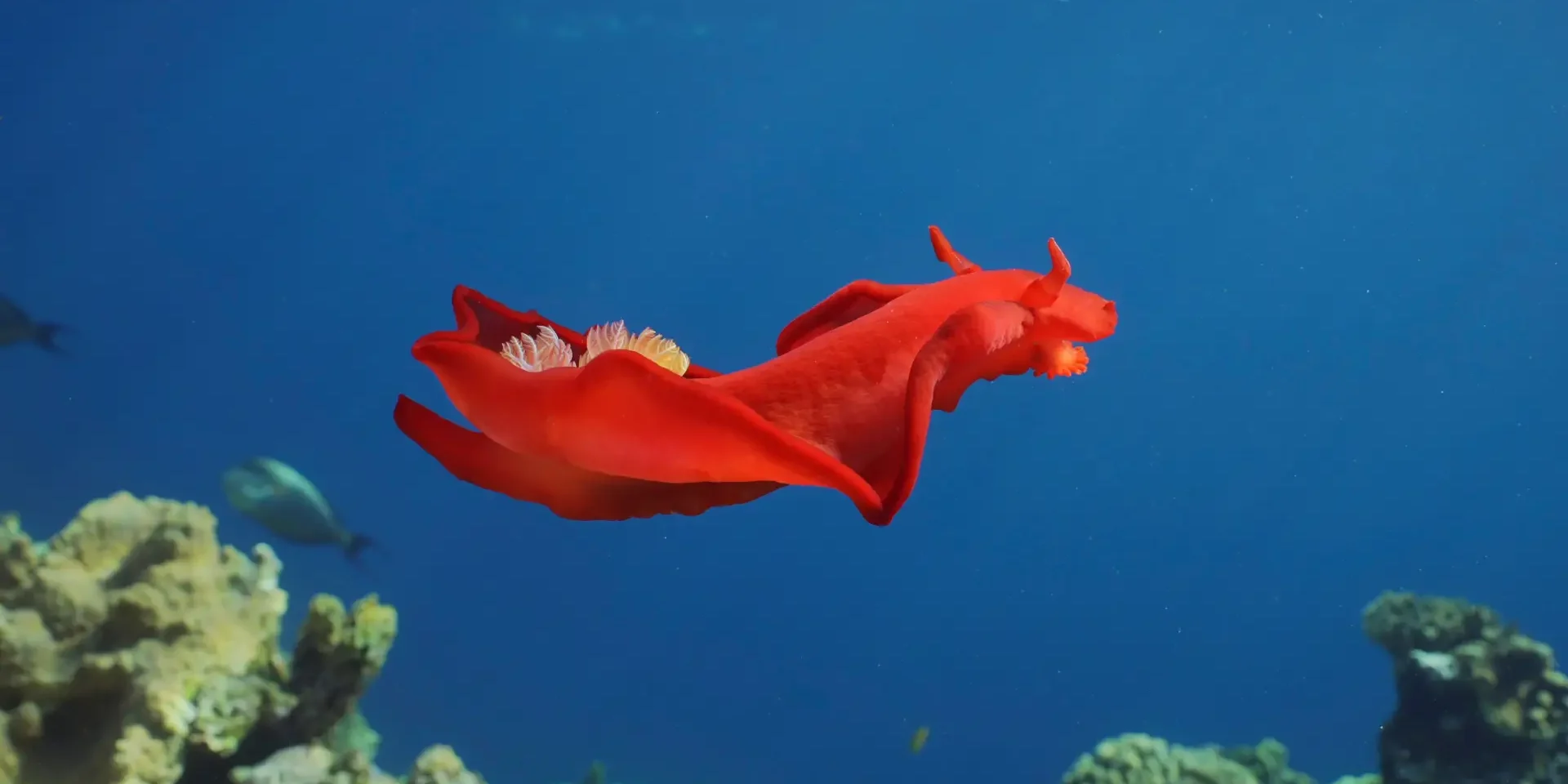The Spanish Dancer Nudibranch: Hurghada’s Elusive Beauty
There are few sights in the Red Sea as enchanting as the graceful, undulating movement of a Spanish Dancer nudibranch. Named for its resemblance to a flamenco dancer’s swirling dress, this flamboyant sea slug is a rare but unforgettable encounter for divers lucky enough to spot one. Hurghada’s calm, warm waters make it one of the best places while scuba diving in Egypt to witness the Spanish Dancer in its natural habitat, particularly for those with sharp eyes and a patient approach during daylight dives with scubadore hurghada.
What Is the Spanish Dancer?
The Spanish Dancer (Hexabranchus sanguineus) is a species of dorid nudibranch, a type of sea slug known for its vivid colors and lack of a protective shell. The name “Hexabranchus” means “six gills,” referencing the feathery gill structures on its back. “Sanguineus” translates to “blood red,” describing its vibrant body coloration.

Key Facts:
- Size: Can grow up to 60 cm (24 inches), making it one of the largest nudibranchs in the world
- Color: Bright red to orange with patterns of white or yellow lines and spots
- Habitat: Coral reefs and sandy slopes, often hiding under ledges or within crevices
- Activity: Primarily nocturnal, but occasionally active during the day
- Defense: Emits toxins and can swim to evade predators
Why Is It Called the Spanish Dancer?
The nickname comes from its elegant swimming motion. When disturbed or on the move, the Spanish Dancer unfurls its mantle and waves it in a sinuous, rippling fashion. This dance-like movement resembles the flowing skirt of a flamenco dancer, creating a spectacle that leaves a lasting impression on divers.
Where to See the Spanish Dancer in Hurghada
While the Spanish Dancer is elusive and most active at night, lucky divers sometimes spot them tucked under ledges or moving slowly across the reef during early morning or late afternoon dives. Scubadore hurghada’s experienced guides know the signs and favored hiding spots to increase your chances of a sighting.
Best Dive Sites in Hurghada for Spanish Dancer Sightings:
- Fanadir South: Known for sandy slopes, coral ledges, and high macro biodiversity
- Small Giftun (sheltered side): Offers crevices and ledges where nudibranchs rest
- El Fanous East: A great site for macro lovers with occasional Spanish Dancer sightings
Keep in mind that while sightings can never be guaranteed, staying observant and diving with a knowledgeable guide can make all the difference.
The Role of the Spanish Dancer in the Ecosystem
Though beautiful, the Spanish Dancer plays an important ecological role:
- Predator of Sponges: Helps maintain sponge populations and reef health
- Host to Emperor Shrimp: Occasionally, tiny shrimp live symbiotically on its back, feeding on parasites or leftover food
- Warning Coloration: Its bold colors signal toxicity to predators, discouraging attacks
Its presence indicates a healthy reef system with balanced biodiversity—a good sign for divers and conservationists alike.
Tips for Spotting and Photographing the Spanish Dancer
If you’re hoping to see or capture this majestic nudibranch on camera, here are some expert tips:
1. Dive Slowly and Observe Closely
- Look along reef walls and under ledges where they may be resting
- Maintain good buoyancy to avoid stirring sediment or disturbing the reef
2. Use Proper Lighting
- A good dive torch or strobe can help reveal vibrant colors
- Avoid overexposing your shot—angle your light carefully
3. Practice Patience and Respect
- Never touch or chase the nudibranch
- Keep a respectful distance for ethical viewing and clearer photography
Why Divers Love the Spanish Dancer
There’s something magical about spotting a Spanish Dancer in the wild. Its size, color, and movement make it seem more like a creature from a dream than a real marine animal. For many divers, it’s a bucket list sighting and a special highlight of any Red Sea dive.
Discover the Unexpected with scubadore hurghada
At scubadore hurghada, we specialize in guided dives that highlight the Red Sea’s most intriguing and beautiful marine life. While we do not conduct night dives, our skilled dive guides know exactly where and how to search for rare finds like the Spanish Dancer during daylight hours.
Join us on your next dive and experience the wonder of Hurghada’s reefs—with a bit of luck, you just might catch a glimpse of this flamboyant underwater performer.







